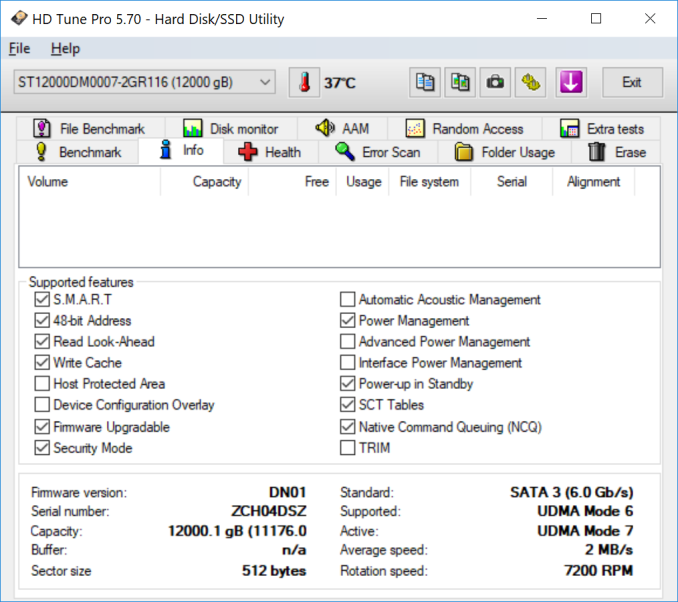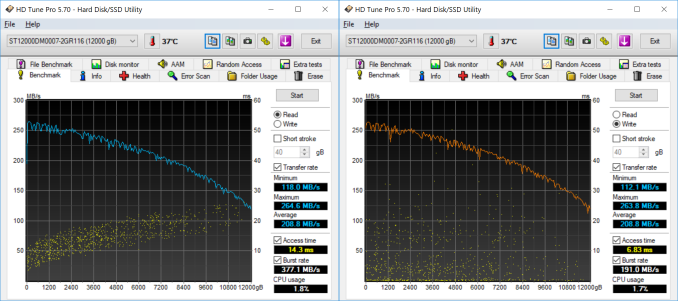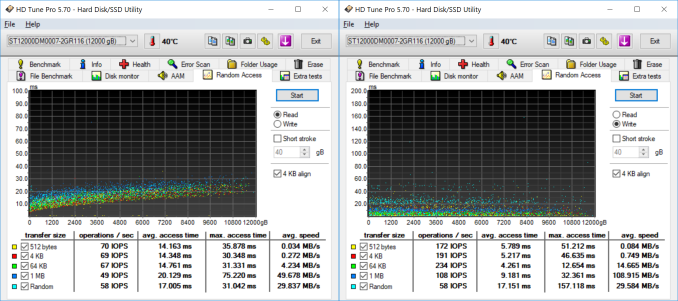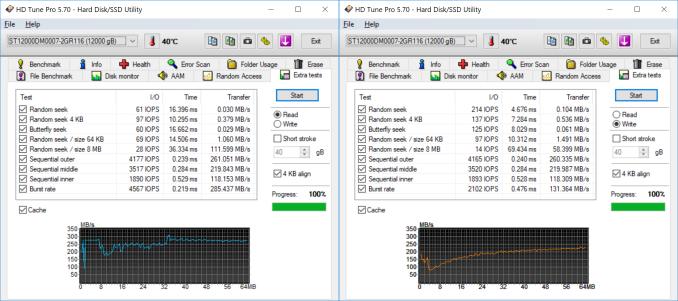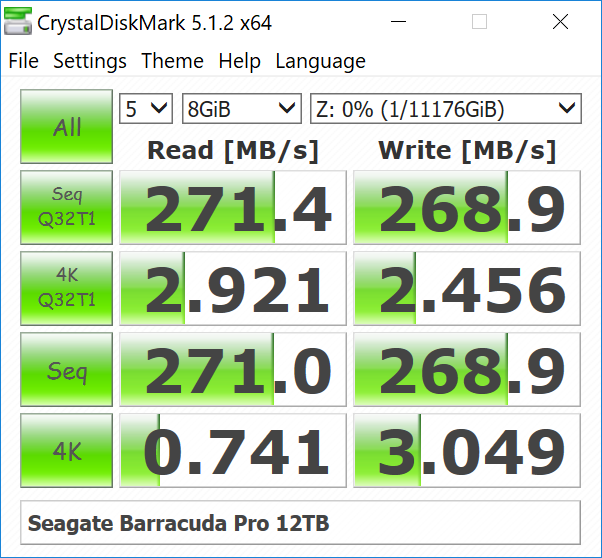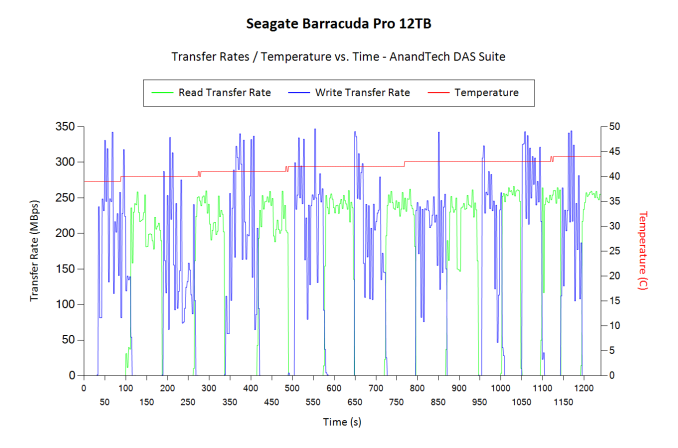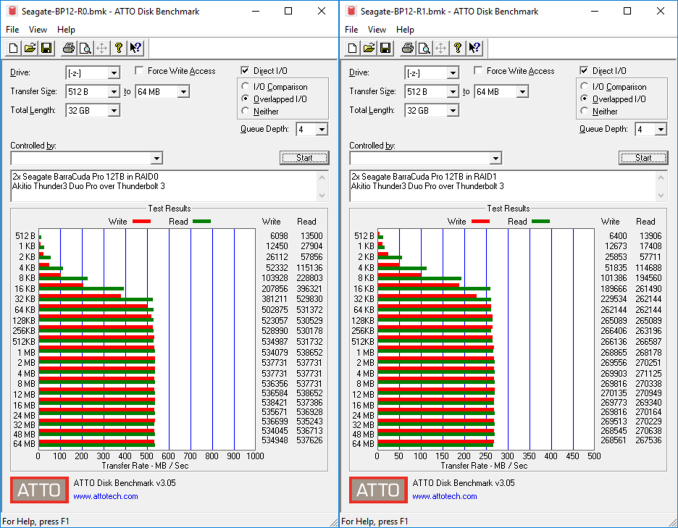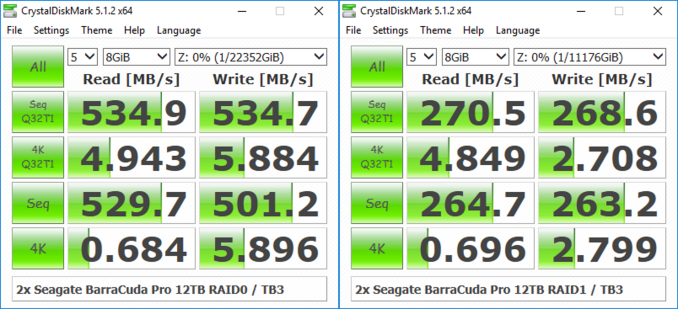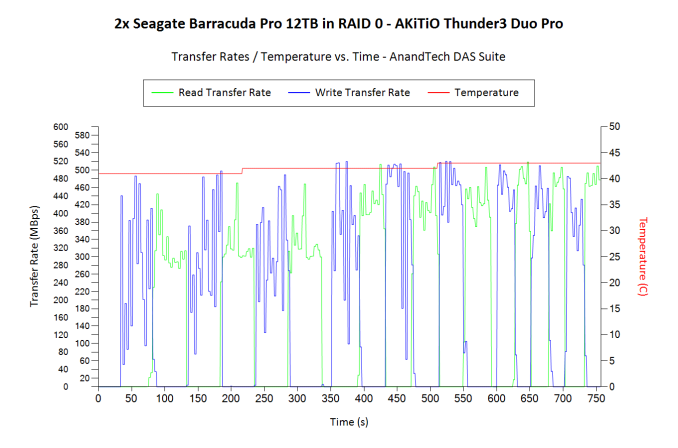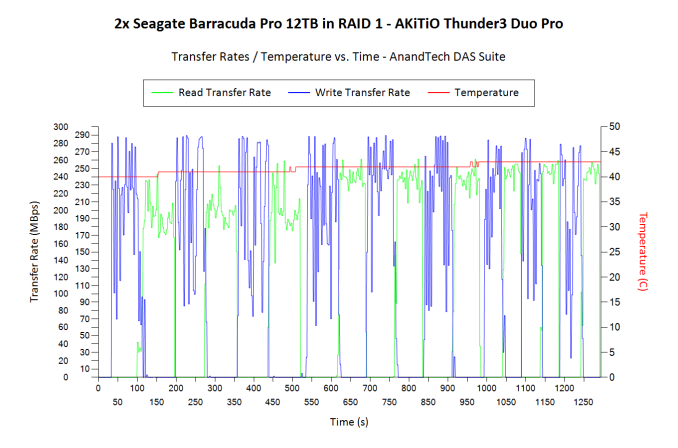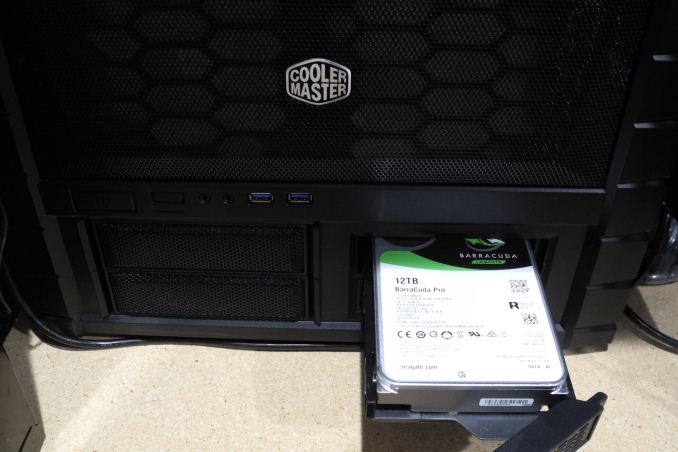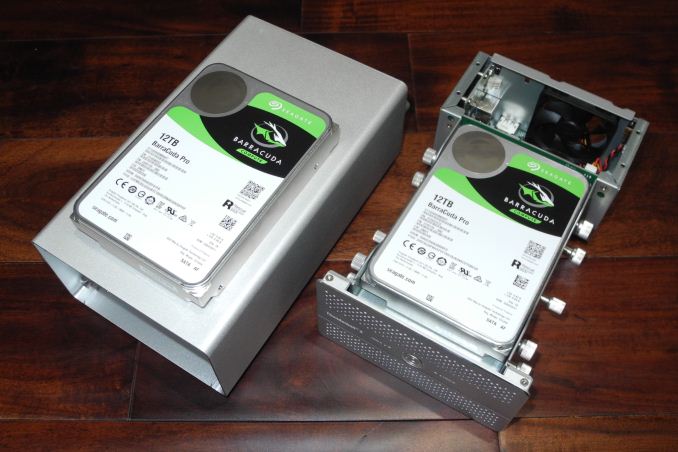
Original Link: https://www.anandtech.com/show/12035/seagate-barracuda-pro-12tb-hdd-review
Seagate BarraCuda Pro 12TB HDD Review
by Ganesh T S on November 15, 2017 8:00 AM EST- Posted in
- Storage
- Seagate
- HDDs
- Helium HDD
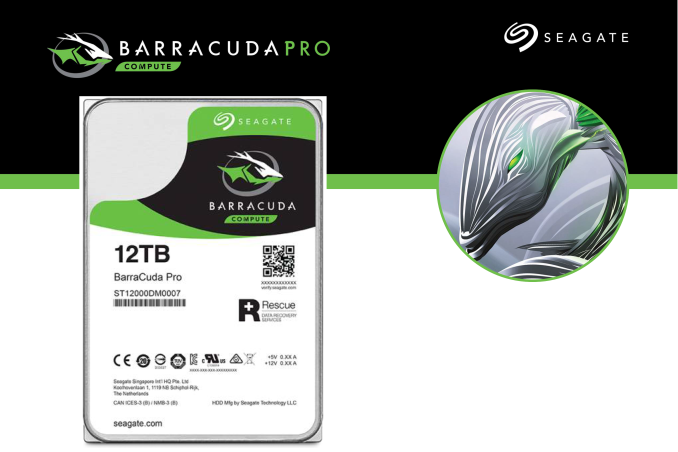
Data storage requirements have seen an exponential increase over the last several years. Both cloud and local storage requirements continue to be served by hard drives where workloads are either largely sequential or not performance sensitive. While the advancements in storage capacity have primarily served the interests of datacenters (enabling more storage capacity per rack), the products have trickled down to consumers in the form of drives for NAS (network-attached storage) units and pre-installed in external / DAS (direct-attached storage) enclosures. Seagate is the only one of the three hard drive vendors to target the desktop storage market with their highest capacity drives. We looked at the 10TB BarraCuda Pro drive last year, and the 12TB follow-up was launched last month.
Introduction
The Seagate BarraCuda Pro 12TB is a 7200RPM SATAIII (6 Gbps) hard drive with a 256MB multi-segmented DRAM cache. It features eight PMR platters with a 923 Gb/in2 areal density in a sealed enclosure filled with helium. According to Seagate, it typically draws around 7.8W, making it one of the most power efficient high-capacity 3.5" hard drives in the market. It targets creative professionals with high-performance desktops, home servers and/or direct-attached storage units. It is meant for 24x7 usage (unlike traditional desktop-class hard drives) and carries a workload rating of 300TB/year, backed by a 5-year warranty. It also comes with a bundled data-recovery service (available for 2 years from date of purchase). The various aspects of the drive are summarized in the table below.
| Seagate BarraCuda Pro 12TB Specifications | |
| Model Number | ST12000DM0007 |
| Interface | SATA 6 Gbps |
| Sector Size / AF | 4096 |
| Rotational Speed | 7200 RPM |
| Cache | 256 MB (Multi-segmented) |
| Rated Load / Unload Cycles | 300 K |
| Non-Recoverable Read Errors / Bits Read | < 1 in 1015 |
| MTBF | 1M hours |
| Rated Workload | ~ 300 TB/yr |
| Operating Temperature Range | 0 to 60 C |
| Physical Parameters | 14.7 x 10.19 x 2.61 cm; 705 g |
| Warranty | 5 years |
| Street Price (in USD, as-on-date) | $500 |
Note that the weight has increased compared to the 10TB drive introduced last year. While the 10TB version had seven platters, the 12TB one bumps it up to eight.
A high-level overview of the various supported SATA features is provided by HD Tune Pro, and shows support for common mechanical features such as NCQ.
The main focus of our evaluation is the performance of the HDD as an internal disk drive in a PC. The other suggested use-case for the BarraCuda Pro is in direct-attached storage devices. The evaluation in these two modes was done with the help of our direct-attached storage testbed.
The internal drive scenario was tested by connecting the drive to one of the SATA ports off the PCH, while the Akitio Thunder3 Duo Pro was used for evaluating the performance in a DAS. The Thunder3 Duo Pro was connected to one of our testbed's Thunderbolt 3 Type-C port. The controller itself connects to the Z170 PCH via a PCIe 3.0 x4 link.
| AnandTech DAS Testbed Configuration | |
| Motherboard | GIGABYTE Z170X-UD5 TH ATX |
| CPU | Intel Core i5-6600K |
| Memory | G.Skill Ripjaws 4 F4-2133C15-8GRR 32 GB ( 4x 8GB) DDR4-2133 @ 15-15-15-35 |
| OS Drive | Samsung SM951 MZVPV256 NVMe 256 GB |
| SATA Devices | Corsair Neutron XT SSD 480 GB Intel SSD 730 Series 480 GB |
| Add-on Card | None |
| Chassis | Cooler Master HAF XB EVO |
| PSU | Cooler Master V750 750 W |
| OS | Windows 10 Pro x64 |
| Thanks to Cooler Master, GIGABYTE, G.Skill and Intel for the build components | |
The full details of the reasoning behind choosing the above build components can be found here.
Performance - Internal Storage Mode
The performance of an internal storage device is dependent on the performance characteristics of the device as well as the file system being used. In order to isolate the effects of the latter, we first benchmarked the raw drives using HD Tune Pro 5.70. It was then formatted in NTFS and subject to our standard direct-attached benchmark suite.
Raw Drive Performance
HD Tune Pro allows us to run a variety of tests to determine transfer rates and IOPS for various artificial workloads. In addition, it also allows us to visualize how the performance varies as the tracking head moves from the outer parts of the platter towards the center (i.e, transfer rates as a function of the block address).
Empty drives are bound to perform very well, but, depending on the location of the data in the drive, we find that access rates can go as low as 112 MBps for sequential workloads. Write access times are a bit unpredictable due to the multi-segmented cache.
Random accesses are never the strong points of hard drives, and we see that the BarraCuda Pro delivers around 70 IOPS for 4K random reads and writes.
The extra tests help in putting some numbers to sequential accesses targeting different areas of the drive. It also provides some interesting numbers relevant to various random access workloads.
DAS Benchmarks
Consumers opting for drives such as the 12TB Seagate BarraCuda Pro typically need high-capacity local storage for holding and editing / processing large-sized multimedia files. Prior to taking a look at the real-life benchmarks, we first check what CrystalDiskMark has to report for the drive.
In order to tackle the real-life use-case of transferring large amounts of data back and forth from the drive, we created three test folders with the following characteristics:
- Photos: 15.6 GB collection of 4320 photos (RAW as well as JPEGs) in 61 sub-folders
- Videos: 16.1 GB collection of 244 videos (MP4 as well as MOVs) in 6 sub-folders
- BR: 10.7 GB Blu-ray folder structure of the IDT Benchmark Blu-ray (the same that we use in our robocopy tests for NAS systems)
| Seagate BarraCuda Pro 12TB robocopy Benchmarks (MBps) | ||
| Write Bandwidth | Read Bandwidth | |
| Photos | 219.23 | 205.51 |
| Videos | 231.42 | 219.46 |
| Blu-ray Folder | 234.05 | 230.02 |
These numbers are consistently around 15 - 20 MBps more than what we obtained for the 10TB drives last year.
While processing our DAS suite, we also recorded the instantaneous transfer rates and temperature of the drive. Compared to typical disk drives, the write transfers show higher instantaneous speeds due to a combination of the firmware and the 256 MB cache inside the drive. However, sustained write rates are comparable to other high-capacity drives when the cache is exhausted. The temperature of the unit at the end of the transfers (more than 250GB of traffic) rose by less than 5C, pointing to the power-efficiency of the platform.
For the use-case involving editing of multimedia files directly off the disk, we take advantage of PCMark 8's storage benchmark. The storage workload is a good example of a user workload, involving games as well as multimedia editing applications. The command line version allows us to cherry-pick storage traces to run on a target drive. We chose the following traces.
- Adobe Photoshop (Light)
- Adobe Photoshop (Heavy)
- Adobe After Effects
- Adobe Illustrator
Usually, PCMark 8 reports time to complete the trace, but the detailed log report has the read and write bandwidth figures which we present in our performance graphs. Note that the bandwidth number reported in the results don't involve idle time compression. Results might appear low, but that is part of the workload characteristic.
| Seagate BarraCuda Pro 12TB PCMark8 Storage Benchmarks (MBps) | ||
| Write Bandwidth | Read Bandwidth | |
| Adobe Photoshop (Light) | 250.22 | 9.06 |
| Adobe Photoshop (Heavy) | 246.88 | 11.48 |
| Adobe After Effects | 89.74 | 8.85 |
| Adobe Illustrator | 196.38 | 8.42 |
Compared to the results from the 10TB drive last year, we find that the read workloads are slightly worse off, but, the write workloads are much faster.
Performance - Direct Attached Storage Mode
Seagate suggests that the BarraCuda Pro Compute drives are suitable for use in direct-attached storage systems. We evaluated the performance in such a usage scenario using one of the highest performing 2-bay DAS units currently in the market - the Akitio Thunder3 Duo Pro, connected to our testbed via a Thunderbolt 3 interface.
Prior to processing real-life workloads, we first checked quick artificial access traces using ATTO and CrystalDiskMark.
We find that the performance remains consistent irrespective of workload size as long as the sequential access characteristic holds. Two drives in RAID 0 can sustain 530 MBps+ reads and writes. RAID 1 performance is similar to the standalone drive performance.
Both RAID0 and RAID1 configurations were subject to our standard DAS test suite described in the previous section. The robocopy test suite gave the following results.
| Akitio Thunder3 Duo Pro + 2x Seagate BarraCuda Pro 12TB (Thunderbolt 3) robocopy Benchmarks (MBps) |
||||
| Write Bandwidth | Read Bandwidth | |||
| RAID 0 | RAID 1 | RAID 0 | RAID 1 | |
| Photos | 334.00 | 215.79 | 303.85 | 184.12 |
| Videos | 432.76 | 221.45 | 396.39 | 222.44 |
| Blu-ray Folder | 421.10 | 219.98 | 434.73 | 224.72 |
There is no difference in the performance consistency between either RAID configuration. The behavior is largely similar to the internal drive scenario, except for the RAID 0 absolute bandwidth numbers. Thanks to the enclosure's fan, the temperature increase is also not as much as what we observed in the internal drive case.
We also processed select workloads from PCMark 8's storage bench.
| Akitio Thunder3 Duo Pro + 2x Seagate BarraCuda Pro 12TB (Thunderbolt 3) PCMark8 Storage Benchmarks (MBps) |
|||||
| Write Bandwidth | Read Bandwidth | ||||
| RAID 0 | RAID 1 | RAID 0 | RAID 1 | ||
| Adobe Photoshop (Light) | 313.76 | 201.22 | 10.51 | 9.16 | |
| Adobe Photoshop (Heavy) | 304.70 | 196.83 | 12.46 | 10.99 | |
| Adobe After Effects | 95.00 | 74.12 | 9.75 | 9.54 | |
| Adobe Illustrator | 214.10 | 168.92 | 9.39 | 9.11 | |
A significant speed-up in response time is achieved while dealing with multimedia files stored in a RAID 0 configuration of two BarraCuda Pro 12TB drives in a Thunderbolt 3 enclosure. Combined with the consistency shown, we can say that our results back up Segate's claims regarding the firmware tuning of BarraCuda Pro drives for specific application scenarios.
Concluding Remarks
The BarraCuda Pro 12TB is a unique product in the market. It is not often that we see a leading capacity 'desktop-class' hard drive rated for 24x7 operation or workload ratings of 300TB/year. To top it all, Seagate is even throwing in a 5-year warranty. A 2-year data recovery service (DRS) is also included. The lower load/unload cycles rating (300K, compared to the 600K in the equivalent NAS drives) and MTBF (1M hours, compared to 1.2M for the equivalent Pro NAS drive) are slightly disappointing aspects, but, they are more than made up for by the warranty and DRS.
In the gaming desktops market in particular, we are seeing per-game storage requirements running into 100s of GBs, and SSDs continuing to remain above $0.33/GB. Under these circumstances, high-capacity hard drives are bound to become relevant again. In our evaluation, the drive managed to perform quite well for largely sequential workloads (typical of bulk storage requirements in gaming workloads).
Consumers dealing with content creation can also use the BarraCuda Pro as part of a direct-attached storage system. For single-user scenarios, a DAS inherently makes more sense than a NAS. It allows use of enclosures sporting interfaces with higher speeds. The BarraCuda Pro 12TB drive shows great performance in such devices.
In our evaluation, the drive successfully met all of Seagate's claims. Helium drives have achieved economies of scale and are now mass-market devices. The current street price of the BarraCuda Pro 12TB ($500) is already lower than the suggested launch price ($530). The other 12TB Seagate options are the IronWolf NAS drive at $450, IronWolf Pro at $510, and the Enterprise Capacity at $469. We also have the Western Digital WD Gold at $522. The IronWolf has a lower workload rating (180 TB/yr vs 300 TB/yr) and also doesn't have the data recovery service available with the BarraCuda Pro and the IronWolf Pro. None of the enterprise drives carry the DRS option, which justifies the premium associated with the two Seagate Pro drives.
Pricing the BarraCuda Pro mid-point between the IronWolf and the IronWolf Pro would have made it an obvious choice for a high-capacity desktop / DAS usage drive. As it currently stands, it is difficult to choose between the IronWolf Pro and the BarraCuda Pro, as only $10 separates them. The IronWolf Pro also has a higher load/unload cycle rating. Seagate claims that the firmware in the BarraCuda Pro is tuned specifically for typical high-end desktop workloads. However, it is unlikely that consumers will see obvious performance differences between the two drives in typical single-user scenarios. In the end, the DRS ensures that customers are unlikely to go wrong with either the IronWolf Pro or the BarraCuda Pro, irrespective of the end application.

